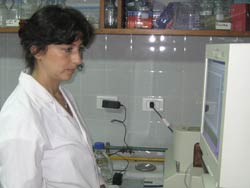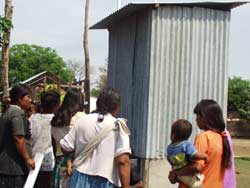Working for clean water in Argentina
April 2010 | Volume 9, Issue 2
Dr. Veronica Rajal
Clean Water Scientist
Professor, National University of Argentina at Salta
Clean water is the cause that motivates former Fogarty trainee Dr. Veronica Rajal. Water can be contaminated with pesticides, industrial chemicals, human and animal waste, and arsenic, among other compounds. She monitors the rivers, lakes and irrigation channels in her native region in northwest Argentina for bacteria, virus and parasites.
More than half the population in Rajal’s study area lives in poverty. Many lack safe drinking water and hygienic sanitation. Acute diarrhea causes about 70,000 deaths and hospitalizations a year in Argentina. Infants and children are particularly susceptible.

Photo courtesy of Dr. Rajal
With Fogarty support, Dr. Veronica Rajal completed
two years of postdoctoral research training at the
University of California, Davis, focusing on the
detection of disease-causing pathogens in water.
While examining a polluted river recently, Rajal’s team contacted a nearby school to obtain a control sample of water from the school’s tap. It turned out to be more contaminated than the river. The researchers monitored the school’s water source and provided a filtration system. “The commitment of the principal and the curiosity and participation of the children inspired us,” says Rajal.
After earning her Ph.D. in biotechnology at Argentina’s National University at Salta, she completed two years of postdoctoral research training under Fogarty grantee Dr. Jerold Last at the University of California, Davis. Her training was funded by Fogarty’s International Training and Research in Environmental and Occupational Health.
Despite no prior experience with molecular biology methods, Rajal was able to lead research projects while learning new skills. “She brought tremendous energy and curiosity to my laboratory,” says UC Davis professor Dr. Stefan Wuertz. “With her excellent mentoring skills, my graduate students looked to her for advice when designing and performing experiments.”
To better detect disease-causing bacteria and other pathogens in water samples, Rajal learned to use a method called real-time polymerase chain reaction that uses enzyme activity to identify micro-organisms through their DNA. She became so proficient, she was the lead author on the first-ever paper combining real time PCR with another advanced molecular technique, hollow fiber ultrafiltration.

Photo courtesy of Pan American Health Organization
Many areas of Argentina lack safe drinking water
and proper sanitation, such as this new outhouse,
resulting in a significant number of preventable
diarrhea-associated hospitalizations and deaths.
Water contamination comes from human, animal
and industrial waste, pesticides and arsenic.
Rajal says her postdoctoral training qualified her for a higher level research position when she returned home to Salta, where she also teaches biotechnology, microbiology, and toxicology. She says her training also helped her win a reentry grant from the Argentine Research Council.
She is developing a master’s program in environmental engineering with a grant from the American Society for Microbiology and UNESCO, and has published ten journal articles, four of which she attributes to her post-doctoral training. In addition, she has created a program to study water and soil contamination.
Rajal’s training benefited her region in an unexpected way - when the expensive equipment necessary for real time PCR was being replaced at UC Davis, the university donated the old one to Rajal’s lab in Salta. That has made it possible for her to provide the region’s only instruction in real-time PCR. When the H1N1 epidemic hit Argentina last summer, Rajal’s lab was asked to help because they had the only equipment that could rapidly and correctly identify specific influenza virus strains.
For the future, Rajal says, “My hope is that public health and environmental authorities pay more attention to the fact that most gastrointestinal diseases, which especially affect infants, are attributable to contaminated water. Monitoring identifies the sources, which can be managed and mitigated.”
More Information
Validation of hollow fiber ultrafiltration and real-time PCR using bacteriophage PP7 as surrogate for the quantification of viruses from water samples. V.B. Rajal, B.S. McSwain, D.E. Thompson, C.M. Leutenegger, B.J. Kildare y S. Wuertz. Water Research, 2007, 41: 1411-1422.
To view Adobe PDF files,
download current, free accessible plug-ins from Adobe's website.
Related Fogarty Programs
Related World Regions / Countries